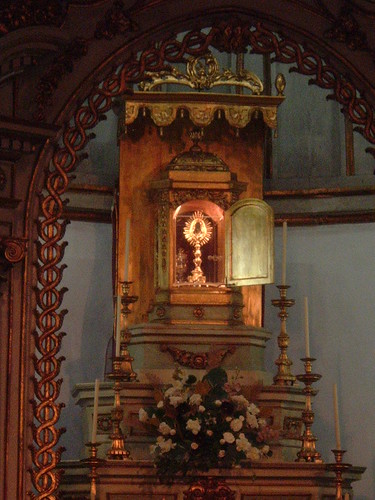
The story of the miracle centers on an early-13th-century woman in Santarém, Portugal, with an unfaithful husband. Desperate to regain his faithfulness and save her marriage, she consulted a sorceress. The sorceress said she would cure the husband's infidelity for the price of a consecrated host. After much deliberation, the woman decided to commit the sacrilege.
The next time she attended Mass at the 12th-century Church of St. Stephen, she took the consecrated host from her mouth, wrapped it in a veil and headed quickly for the door. Before she had taken more than a few steps, the host began to bleed. It bled so much that concerned parishioners thought she had cut her hand and attempted to help, but she ran out of the church toward her home.
Back at home, she threw the bloody host in a trunk in her bedroom. Her husband did not come home until late, as usual. In the middle of the night, they were both awoken by a mysterious, brilliant light emanating from the trunk. The light illuminated the entire room. The woman confessed to her husband what she had done and they both knelt in repentance and adoration before the miracle.
The next morning, the couple told the parish priest what had happened. The priest returned the Host to the Church of St. Stephen in a solemn procession. The host continued to bleed for three days. Finally it was decided to place the holy Host (still bleeding) in a reliquary made of melted beeswax. It was then placed in a Tabernacle.
Nineteen years passed and in 1266 when a canonical investigation was called to study the miracle, it was discovered that a second miracle had occurred! The wax container was found broken into pieces, and the host was found enclosed in a crystal ampoule (pyx). This pyx was placed in a gold monstrance, where it can be seen and contemplated today. The Blood is still in liquid form, these 750 years after the Miracle occurred.
After the investigation, the Catholic Church approved the recognition of the miracle. The Church of St. Stephen was renamed the Church of the Holy Miracle, and it is one of Portugal's most-visited pilgrimage sites. St. Francis Xavier visited the Church of the Holy Miracle before setting off for missionary work in India.
The next time she attended Mass at the 12th-century Church of St. Stephen, she took the consecrated host from her mouth, wrapped it in a veil and headed quickly for the door. Before she had taken more than a few steps, the host began to bleed. It bled so much that concerned parishioners thought she had cut her hand and attempted to help, but she ran out of the church toward her home.
Back at home, she threw the bloody host in a trunk in her bedroom. Her husband did not come home until late, as usual. In the middle of the night, they were both awoken by a mysterious, brilliant light emanating from the trunk. The light illuminated the entire room. The woman confessed to her husband what she had done and they both knelt in repentance and adoration before the miracle.
The next morning, the couple told the parish priest what had happened. The priest returned the Host to the Church of St. Stephen in a solemn procession. The host continued to bleed for three days. Finally it was decided to place the holy Host (still bleeding) in a reliquary made of melted beeswax. It was then placed in a Tabernacle.
Nineteen years passed and in 1266 when a canonical investigation was called to study the miracle, it was discovered that a second miracle had occurred! The wax container was found broken into pieces, and the host was found enclosed in a crystal ampoule (pyx). This pyx was placed in a gold monstrance, where it can be seen and contemplated today. The Blood is still in liquid form, these 750 years after the Miracle occurred.
After the investigation, the Catholic Church approved the recognition of the miracle. The Church of St. Stephen was renamed the Church of the Holy Miracle, and it is one of Portugal's most-visited pilgrimage sites. St. Francis Xavier visited the Church of the Holy Miracle before setting off for missionary work in India.
'My God, I believe, I adore, I hope and I love You!'
is fittingly posted at the site of the church.


No comments:
Post a Comment